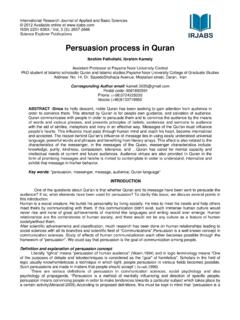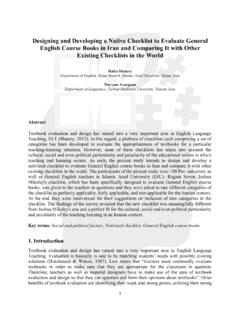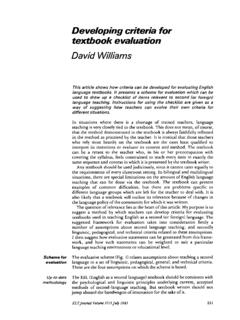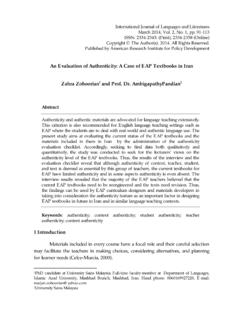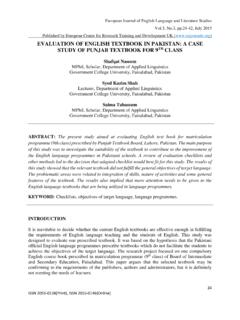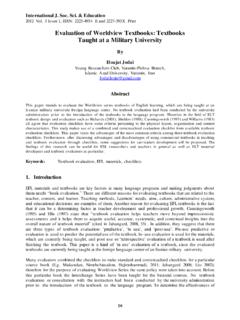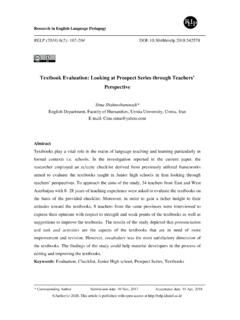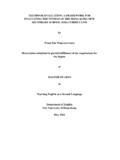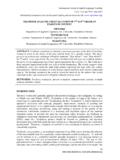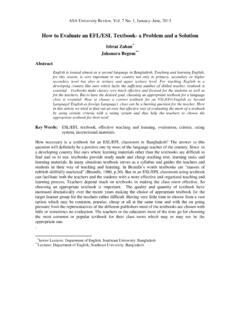Transcription of A Critical Look at Textbook Evaluation: A Case Study of ...
1 InternationalResearch Journal of Applied and Basic Sciences 2013 Available online 2251-838X /Vol,4(2):372-380 Science Explorer PublicationsA Critical Look atTextbook evaluation : A Case Studyof Evaluating an ESP Course-Book: english forInternational TourismSaeid Najafi Sarem1, Hadi Hamidi2, Rezvan of english , Hamedan branch,Islamic Azad University, Hamedan2. Department of english , Science and Research branch, Islamic Azad University, Mazandaran3. Faculty member, Islamic Azad University, Asadabad, Hamedan*Corresponding Author students, and textbooks are considered as the three major elements in theprocess of education. Against the common belief that students are the key in this direction, many scholarshold the view that textbooks are the heart of educationwith regard to the fact that both teachers andstudents areto a large extentdependent on the on this view, textbookscontrol teacher,students as well as the dynamics of the classroom.
2 Therefore, great care has to be taken in selecting themost appropriate textbooks capable of meetingsuch factors asteachers interests and expectations,students needs, and finally the course objective as is not a goal achieved overnight; rather itrequires careful scrutiny and analysis. One solution to this problem is opting forevaluation checklistswhich have been designed mostly by material developers based on which they can analyze availabletextbooks in order for the selection and development of the most perfect ones. In this respect, the currentstudy has been developed in order to analyze an available specialized Textbook for the students ofTourism on the basis oftheevaluation checklist constructed by Daoud and Celce-Murcia (1979). Theresults of the current Study have important implications both for language teachers and materialdevelopers which will be discussed : Textbook , Textbook evaluation , evaluation ChecklistINTRODUCTIONAny person involved within the realm of education has encountered the term evaluation in many casesoften integrating it with course evaluation or program evaluation and more specificallywithteacher evaluation ,student evaluation and more recently Textbook evaluation .
3 Thus, at the very beginning it seems essential to knowwhat the term evaluation means. evaluation is a process of inquiry in which data are gathered through differentinstruments and from different sources. This information is interpreted to make important decisions based on theresearch results. These decisions might require a change and effect a drastic alteration in the outline and processof a language program instruction. All these efforts are made to the betterment of a course of Study and bringingabout satisfactory results. Therefore, Program evaluation is a formof enquiry which describes the achievements ofa given program, provides explanations for these, and sets out ways in which further development might berealized (Kiely, 2009). Kiely (2009) argues that evaluation tries to ensure quality assurance and enhancement and creates a dialogue within programs for ongoing improvement of learning opportunities.
4 evaluation cancontribute not only to learning process but also to teacher change and and Germaine(1992) define evaluation as adynamic process which investigates the suitability and appropriateness of an existingpractice. It is a useful device for both teachers and material writers as an underlying element in the development ofinnovations and modifications within the teaching /learning was mentioned, one major area which has drawn the attention of many language scholars and morespecifically curriculum developers is the branch of Textbook evaluation .Nowadays, in educational practicesthroughout the world,textbooks play a vital role,sincethey are considered asthe means of conveying the requiredmaterials and knowledge between teachers and students. To do this appropriately, books have to bear certainIntl.
5 Res. J. Appl. Basic. Sci. Vol., 4 (2),372-380, 2013373characteristics in their every aspect including physical andthematic considerations. With this respect, in lastdecades a movement known as Textbook evaluation began to emerge whose goal was to construct checklistsbased on whicha book could be analyzed in detail in order to assure its usefulness and practicality with suchfactors as proficiency level ofstudents, learners needs, course objectives, gender, and many other these factors have to be properly met through Textbook s greatly influence howcontent is the above points into account, the current studyis conducted to take an analytical look at the book english for International Tourism which has been developed as a Textbook for those students who major evaluation is not merely confined to general ELT textbooks.
6 Rather it seems to be even morecrucial when it comes to the field of ESP which was introduced in the realm of language teaching and learningfollowing 1960s. Textbooksdesigned for specializedprogram of studiesshould possess characteristics appropriateto course objectives, learners needs, their proficiency level as well as many other contextual guaranteethe existence of such factors, course-book developers must conduct detailed evaluationsof such books before theyare used. To have a practical example of this process, this Study tries to present an evaluation of aspecializedtextbook for ReviewTextbooks: Pros and ConsEnglish language instruction has many important components but the essential constituents to manyESL/EFL classrooms and programs are the textbooks and instruction materials that are often used by languageinstructors.
7 As Hutchinson and Torres (1994) suggest:"The Textbook is an almost universal elementof [ english language] teaching. Millions of copiesare sold every year, and numerous aid projects have been set up to produce them in [various] teaching-learning situation, it seems, is complete until it has its relevant Textbook .Sheldon (1988) suggests that textbooks not only "represent the visible heart of any ELT program" but alsooffer considerable advantages-for both the student and the teacher-when they are being used in the ESL/EFLclassroom. As Sheldon (1988) has pointed out, students often harbor expectations about using a Textbook in theirparticular language classroom and program and believe that published materials have more credibility thanteacher-generated or "in-house" materials. O'Neill (1982) has indicated, textbooks are generally sensitive tostudents' needs, even if they are not designed specifically for them, they are efficient in terms of time and money,and they can and should allow for adaptation and , McKnight, and Raizen (1997) identified textbooks as playing an important role in making the leapfrom intentions and plans to classroom activities, by making content available, organizing it, and setting outlearning tasks in a form designed to be appealing to make the most effective use of a Textbook ,however, teachers must decide which textbooks are appropriate for their needs.
8 A teacher needs to determine theextent to which a Textbook focuses on and is aligned with a coherent set of significant, age-appropriate studentlearning goals that the teacher, school, or district has identified as integral to the understanding of and progress ina particular academic subject. They must also assess how well a Textbook 's instructional design effectivelysupports the attainment of those specified learning goals. The only way to gain this information is through carefulevaluations of textbooks and other curriculum materials. (Schmidt, McKnight, & Raizen, 1997)Cunningsworth (1995) is the potential which textbooks have for serving several additional roles in the ELTcurriculum. He argues that they are an effective resource for self-directed learning, an effective resource forpresentation material, a source of ideas and activities, a reference source for students, a syllabus where theyreflect pre-determined learning objectives, and support for less experienced teachers who have yet to gain , Hutchinson and Torres (1994) have pointed out that textbooks may play a pivotal role ininnovation.
9 They suggest that textbooks can support teachers through potentially disturbing and threateningchange processes, demonstrate new and/or untried methodologies, introduce change gradually, and createscaffolding upon which teachers can build a more creative methodology of (1996) states the advantages of coursebooks as follows:(a) they provide a clear framework which theteacher and the students know where they are going and what is coming next,(b) mostly, they serve as a syllabuswhich includes a carefully planned and balanced selection of language content if it is followed systematically,(c)they provide readymade texts and tasks with possible appropriate level for most of the class, which save time forthe teacher,(d) they are the cheapest way of providing learning material for each student,(e) they are convenientpackages whose components are bound in order,(f) they are useful guides especially for inexperienced teacherswho are occasionally unsure of their language knowledge,(g) They provide autonomythat the students can usethem to learn new material, review and monitor progress in order to be less Res.
10 J. Appl. Basic. Sci. Vol., 4 (2),372-380, 2013374 Despite the advantages mentioned above, textbooks might simultaneously suffer from some problems some ofthe important ones are discussed such as Porreca (1984), Florent and Walter (1989), Clarkeand Clarke (1990), Carrell and Korwitz (1994), and Renner (1997) have demonstrated that many EFL/ESLtextbooks still contain rampant examples of gender bias, sexism, and stereotyping. They describe such gender-related inequities as: the relative invisibility of female characters, the unrealistic and sexist portrayals of both menand women, stereotypes involving social roles, occupations, relationships and actions as well aslinguistic biasessuch as 'gendered' english and sexist language. Findings such as these have led researchers to believe that thecontinuing prevalence of sexism and gender stereotypes in many EFL/ESL textbooks may reflect the unequalpower relationships that still exist between the sexes in many cultures, the prolonged marginalization of females,and the misrepresentations of writers with social attitudes that are incongruent with the present-day realities of thetarget language culture (Sunderland, 1992;Renner, 1997).




